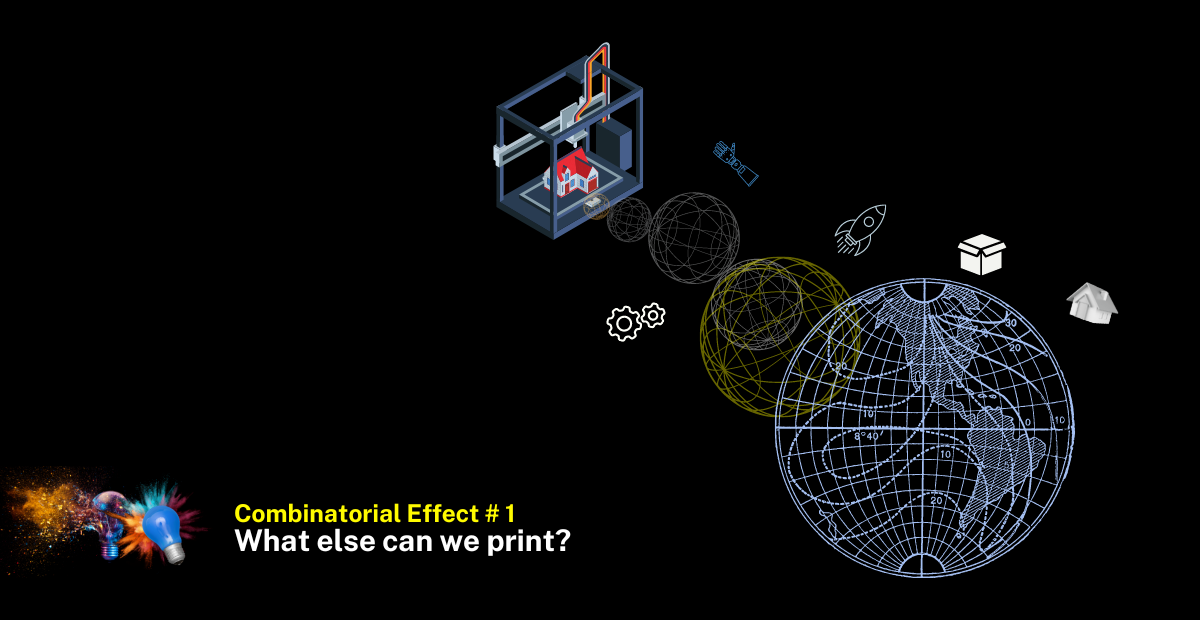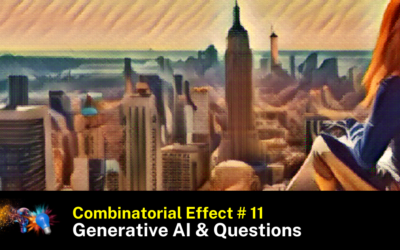Combinatorial Effect # 1
Today, we will take a look at the things that can be printed…
In this issue, we are going to connect some dots that have transformed manufacturing and logistics.
Let´s see this example of the Combinatorial effect.
How do you connect the following dots? 👇 All of them have impacted the evolution of the logistics
🌎 Books ←→ 3D printing ←→ bionic ←→ houses ←→ Rockets
👤 Guttenberg ← → Charles Hull ←→ Tim Ellis & Jordan Noone
By making this type of connection, we can discover insightful lessons behind the stories of people who have led technology growth.
Seeing how people have created solutions will inspire us to innovate: make a discipline to connect the dots.
How does intermediation works in technology?
Sometimes the appearance of a very capable intermediator provides services based on its own infrastructure. Other times, the technology aims to eliminate some of these intermediations.
Since the internet has evolved, we have been seeing more solutions that empower people´s direct interactions without unnecessary intermediation.
Let´s look at some examples to find out more insightful data on the topic:
First, there are 2 examples of centralized intermediation:
- Printing books disrupted the way humanity transferred information.
- Printed telegrams were an effective communication channel 2 centuries ago, and make morse code useful for mass audiences.
Nowadays, some technologies are empowering us to eliminate intermediation:
- 3D-printing
- Messaging
Talking about the first big printing solution: A man called Guttenberg
Before Johannes Guttenberg invented his printing press, information was transmitted orally and in books that were handwritten.
To make a long story short, in the 14th century, Guttenberg developed a printing method with movable types. It makes a huge impact on the way humanity transmitted information to the point of increasing literacy in Europe.
For our analysis, we can see this solution generates a powerful and centralized printing solution: there was a new method for printing multiple copies of information in significantly shorter times.
From this time onward, there was a solution to serve the book printing demand.

Graferocommons, CC BY-SA 3.0 https://creativecommons.org/licenses/by-sa/3.0, via Wikimedia Commons
This solution empowers providers to manage their local markets. In this case, technology helped qualified intermediates to develop their portfolio or printing services.
You can see how intermediation was key to disrupting the speed of information transmission.
The Morse code to understand the role of the middlemen
The old telegrams are a good example of the evolution toward distributed printing.
When the Internet was a distant dream, people sent messages by Morse code, and the people who transmitted them were key players in their communities.
Telegraphers knew everything!
They were the communication intermediaries, and we highlight their role for later comparison with other types of manufacturing and distribution processes.

RedKnight7, CC BY-SA 3.0 https://creativecommons.org/licenses/by-sa/3.0, via Wikimedia Commons
Western Union → 160 years of innovation
Originally, the company was founded as a telegraph business in 1851 in Rochester, New York.
Money transfer service was added 20 years later (in 1871): from those years people knew that every company could be a fintech (as Linas Beliunas says in his newsletter) 😅
And nowadays, all of us know the telegrams transmitted by telegraph do not generate any cent for the company, and on the other hand, money transfers are the core of its business, including the mobile app that allows transfers directly from the devices since 2011.
A phrase to summarize the metamorphosis of information…
The information humanity printed centuries ago has become digital: in ebooks, messages, emails, etc.
And it makes it possible to create the new technologies we are seeing nowadays.
2 disruptors breaking the centralization
At this point, we are going to see some examples in which technology is eliminating intermediations to empower different and more direct people´s interactions.
Let´s dedicate a few words to messaging solutions and a detailed analysis of 3D printing (the core of our article).
Regarding messaging, I just want to say that afterward became digital, the amount of information transmitted grew dramatically 🚀
Skype, Messenger, WhatsApp, Telegram, social networks, etc. have contributed to this data explosion by eliminating unnecessary intermediations in communications.
With the big benefit, it comes a huge inconvenience: the more messages we send, the less quality they have.
This is a key point to remember when thinking about the future of 3D printing.
Origins of 3D printing
As usually happens in technology, there were multiple initiatives aiming to solve specific problems, and after that, these efforts are tested with the audiences for determining their adoption. And time later, maybe some standards were released.
For this article, we take some elements to analyze how previous solutions support the development of new ones (you can say it: Combinatorial Effect happening!) 😎
To be viable, 3D printing required prior developments such as computing power, high-definition monitors, the Internet, design software, and applications, among many other technologies.
This is standing on the shoulders of giants.
3D printing also started as an idea of a brilliant mind
Murray Leinster was the Sci-fi writer who first described a technology capable of converting his drawings into 3D objects, by using a moving arm that molds plastic.
💡 Please remember to promote ideas inside your companies.
Disruption starts in the minds of curious people and happens later in the world.
DJ Mendez reminder 🙂
After almost 4 decades, Mr. Charles “Chuck” Hull, the father of 3D printing, comes in.
The technical word is the method is Stereolithography, which describes the process of adding layers of materials to build a 3D object.
In 1984 he filed a patent for a stereolithography system, a methodology for making previous ideas real. Finally, the patent was approved in 1986.
What did he do later? Mr. Hull started 3D Systems, his own company, to create the devices included in the patent.
After 2 years there were two major outcomes:
- the first commercial 3D printer, and
- the file format to support the process: SLT, which digitally slices the object to produce the information of layers to be printed.

Charles Hull, picture from the official site of the National Inventors Hall of fame.
Mr. Hull was inducted into the National Inventors Hall of Fame in 2014, for his invention of Stereolithography: if you are so curious, the patent number is US Patent No. 4,575,330
“Charles Hull is the inventor of stereolithography, the first commercial rapid prototyping technology commonly known as 3D printing. The earliest applications were in research and development labs and tool rooms, but today 3D printing applications are seemingly endless. The technique has been used to create anything from sports shoes, aircraft components, and artificial limbs to artwork, musical instruments, and clothing”
You can find the link to the patent in the final section of resources.
An anecdote: the price of a 3D printer in that early era was approximately $300,000.
3D printing techniques
Additional methods have been developed in recent decades, as new materials evolve.
In this article, we are going to mention some of them for providing a big picture of how can 3D printing can impact different industries.
A great reference is a list included in Protolabs article “Types of 3D printing technology explained”:
- Stereolithography (SLA)
- Selective Laser Sintering (SLS)
- Fused Deposition Modeling (FDM)
- Digital Light Process (DLP)
- Multi Jet Fusion (MJF)
- PolyJet
- Direct Metal Laser Sintering (DMLS)
- Electron Beam Melting (EBM)
You can see a well-crafted explanation of some techniques in this video from the Rainmaker YouTube channel: https://youtu.be/DMWzMpjSJLM
Or, if you prefer to read, here is the blog post from Protolabs: https://www.protolabs.com/resources/blog/types-of-3d-printing/
But as we know, a single image is worth a thousand words, so let´s see some examples of 3D printing applications.
Humanity is printing incredible things everywhere.
In this section, you can find some of my favorite cases of use, which are impacting different industries.
Printing Hero arms for empowering people.
Open Bionics is a company focused on providing prosthetic arms for adults and children.
Although 3D printing is the foundation that supports the business model, the impact goes far beyond the technology itself. Customers go first, and they consider it to design the whole experience for users.
Please see its website to feel directly how its users are the real heroes behind the arms.
I give 5 stars to Open Bionics for combining key elements to produce awe-inspiring outcomes.
Although 3D printing is the foundation that supports the business model, the impact goes far beyond the technology itself.

Source of the picture: Open Bionics website, in the Disney hero arm covers https://openbionics.com/disney-hero-arm-covers/
Building 1 million homes by 2030
This general purpose is the reason why I love New Story + Icon initiative to print homes in vulnerable communities around the globe.
And it shows again the relevance of adding a significant layer of humanity to technology projects.
Rockets baby!
We are close to seeing the first launch of a completely 3D-printed rocket. (currently scheduled on September 2022) 🚀
Relativity Space is a company that developed its own technology to print metals from very complex designs.
The main objective is to reduce the costs and the manufacturing time of rockets, for making the space industry more affordable in the future.
There is some added value beyond the 3D-printed rockets themselves:
- New technology for printing metals
- Disruptive tools for designing more complex pieces.
- Better materials in terms of temperature, resistance, and durability.
- Radical reduction in space launching.
- Less time to launch
Let´s imagine what could happen if rockets’ time to launch will be reduced to months instead of years.
I kindly suggest you follow Tim Ellis & Jordan Noone, the Founders, and their team to keep updated about this 3D-printing race to the space.
If you want to learn more about how Relativity is printing rockets, see this video produced by the Veritasium YouTube channel: https://youtu.be/kz165f1g8-E
Additional cases of use, we will analyze in future articles:
- Printed organs for improving life quality
- Delicious food that looks amazing
- Silicone prototypes for the health industry
- Remote printing in the space
- and many more
New standards are being developed, what could the future bring to us?
With the rise of decentralized printing, a lot of things are emerging:
- New careers
- Non-traditional ways of quality assurance
- Unstoppable development of new materials and techniques
- Reimagined business models
As more and more components can be printed by users everywhere, new standards and procedures should be developed to guarantee the quality of the elements involved in the upgraded supply chain: distribution, intellectual property, designs, and materials, among others.
This is the room we have to expand our mindsets and make a mark with innovative solutions that integrate the available infrastructure and distributed network, to convert dreams into significant realities.
And it is the best sandbox to combine our knowledge and experience beyond technology.
Let´s combine our ideas to ignite more Combinatorial Effects.

Combinatorial effects takeaways
Can you see it?
When we connect the dots, amazing things happen.
I want to highlight three points:
- Standing on the shoulders of giants: technology innovation requires previous developments to become feasible. In this case, 3D printing evolves after Guttenberg´s printing machines, computers, the internet, and computer-based printing.
- New needs follow a big innovation: after we created new ways to perform some activities, a huge landscape opens before our eyes. 3D printing is evolving every day and it requires new materials, standards, and jobs, among other things to keep moving forward.
- Take a look at the intermediations when you analyze business models: understanding how intermediations are working will help you to get insights about potential improvements.
Finally, it should be noted that this article is just one possible exploration of how to connect the dots, and everyone can make their own.
My main goal is to inspire us to use this approach to discover elements that ignite our problem-solving capacity and innovative mindset.
Keep discovering combinatorial effects in our lives.
See you in the upcoming issues…
______________________________________________________________________
Thanks for reading the whole article, You are a true champion!!!
Please join the mailing list here: https://djmendez.substack.com/
_______________________________________________________________________




0 Comments